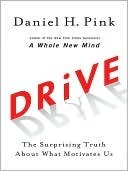More on this book
Community
Kindle Notes & Highlights
richest experiences in our lives aren’t when we’re clamoring for validation from others, but when we’re listening to our own voice—doing something that matters, doing it well, and doing it in the service of a cause larger than ourselves.
idea: Go with a more modest version—20 percent time . . . with training wheels. Start with, say, 10 percent time. That’s just one afternoon of a five-day workweek. (Who among us hasn’t wasted that amount of time at work anyway?) And instead of committing to it forever, try it for six months. By creating this island of autonomy, you’ll help people act on their great ideas and convert their downtime into more productive time. And who knows? Someone in your operation just might invent the next Post-it note.
approval: At any point, without asking permission, anyone in the company can award a $50 bonus to any of her colleagues. “It works because it’s real-time, and it’s not handed down from any management,” the firm’s human resources director told Fast Company. “Any employee who does something exceptional receives recognition from their peers within minutes.” Because these bonuses are noncontingent “now that” rewards, they avoid the seven deadly flaws of most corporate carrots. And because they come from a
them come to you. Take a cue from college professors and set aside one or two hours a week when your schedule is clear and any employee can come in and talk to you about anything that’s on her mind. Your colleagues might benefit and you might learn something.
Harvard’s Teresa Amabile advises, “Set up work groups so that people will stimulate each other and learn from each other, so that they’re not homogeneous in terms of their backgrounds and training. You want people who can really cross-fertilize each other’s ideas.”
• Try a little task-shifting. If someone is bored with his current assignment, see if he can train someone else in the skills he’s already mastered. Then see if he can take on some aspect of a more experienced team member’s work.
But if your organization’s off-sites are falling short, why not try replacing the next one with a FedEx Day? Set aside an entire day where employees can work on anything they choose, however they want, with whomever they’d like. Make sure they have the tools and resources they need. And impose just one rule: People must deliver something—a new idea, a prototype of a product, a better internal process—the following day. Type I organizations
Type I Insight: “Contrary to what we usually believe . . . the best moments in our lives are not the passive, receptive, relaxing times—although such experiences can also be enjoyable, if we have worked hard to attain them. The best moments usually occur when a person’s body or mind is stretched to the limits in a voluntary effort to accomplish something difficult and worthwhile.
approach, which he called Theory X, assumed that people avoid effort, work only for money and security, and therefore need to be controlled. The second, which he called Theory Y, assumed that work is as natural for human beings as play or rest, that initiative and creativity are widespread, and that if people are committed to a goal, they will actually seek responsibility. Theory Y, he argued, was the more accurate—and ultimately more effective—approach.
Type I Insight: “Demanding of knowledge workers that they define their own task and its results is necessary because knowledge workers must be autonomous . . . workers should be asked to think through their own work plans and then to submit them. What am I going to focus on? What results can
be expected for which I should be held accountable? By what deadline?”
“Expending energy trying to motivate people is largely a waste of time,” Collins wrote in Good to Great. “If you have the right people on the bus, they will be self-motivated. The real question then becomes: How do you manage in such a way as not to de-motivate people?”
1. “Lead with questions, not answers.” 2. “Engage in dialogue and debate, not coercion.” 3. “Conduct autopsies, without blame.” 4. “Build ‘red flag’ mechanisms.” In other words, make it easy for employees and customers to speak up when they identify a problem.
“People at all levels stop doing any activity that is a waste of their time, the customer’s time, or their company’s time.” “Employees have the freedom to work any way they want.” “Every meeting is optional.” “There are no work schedules.”
and folks are discussing how to wring another increment of performance out of your workforce, you might ask: ‘To what end, and to whose benefit, are our employees being asked to give of themselves? Have we committed ourselves to a purpose that is truly deserving of their initiative, imagination, and passion?’ ”


